
Harajuku is a district in Shibuya, Tokyo. Harajuku is the common name given to a geographic area spreading from Harajuku Station to Omotesando, corresponding on official maps of Shibuya ward as Jingūmae 1 chōme to 4 chōme. In popular reference, Harajuku also encompasses many smaller backstreets such as Takeshita Street and Cat Street spreading from Sendagaya in the north to Shibuya in the south.

In Japanese culture, Kogal refers to the members of the Gyaru subculture who are still in high school and who incorporate their school uniforms into their dress style. These high school girls are characterized by the typical bleached hair, make-up, shortened skirts, and wearing of loose socks. The word kogal is anglicized from kogyaru, a contraction of kōkōsei gyaru.
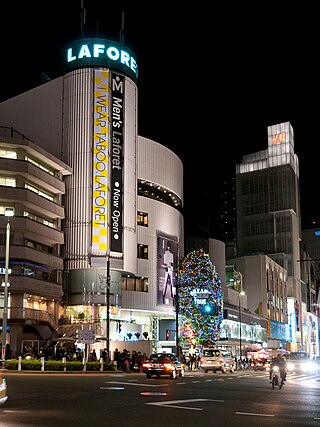
Laforet Harajuku is a department store, residence, and museum complex located in the Harajuku commercial and entertainment district of the Shibuya neighborhood, in Tokyo, Japan.

Lolita fashion is a subculture from Japan that is highly influenced by Victorian clothing and styles from the Rococo period. A very distinctive property of Lolita fashion is the aesthetic of cuteness. This clothing subculture can be categorized into three main substyles: 'Gothic', 'Classic', and 'Sweet'. Many other substyles such as 'Sailor', 'Country', 'Hime' (princess), 'Guro' (grotesque), 'Qi' and 'Wa', 'Punk', 'Shiro' (white), 'Kuro' (black), and 'Steampunk' Lolita also exist. This style evolved into a widely followed subculture in Japan and other countries in the 1990s and 2000s although its popularity has waned in Japan as of the 2010s as alternative fashions fell in popularity.

i-D is a British magazine published biannually and dedicated to fashion, music, art, film and youth culture. The magazine was founded in 1980 by former British Vogue art director Terry Jones. Originally published as a hand-stapled fanzine, it has since evolved into a glossy.
Gyaru (ギャル) pronounced[ɡʲa̠ꜜɾɯ̟ᵝ], is a Japanese fashion subculture for women but a male equivalent also exists. This male equivalent is called a gyaruo. The term gyaru is a Japanese transliteration of the English slang word gal.
Japanese street fashion refers to a number of styles of contemporary modern clothing in Japan. Created from a mix of both local and foreign fashion brands, Japanese street fashions tend to have their own distinctive style, with some considered to be extreme and imaginative, with similarities to the haute couture styles seen on European catwalks.

Omotesandō (表参道) is a zelkova tree-lined avenue located in Shibuya and Minato, Tokyo, stretching from the Meiji Shrine entrance to Aoyama-dōri, where Omotesandō Station can be found.
Baby, the Stars Shine Bright is a Japanese apparel brand created in 1988 by Akinori and Fumiyo Isobe. The brand specializes in lolita fashion and has been widely known for its "sweet" aesthetic. In 2004, Baby, the Stars Shine Bright launched Alice and the Pirates, a sub-brand centered on gothic and punk lolita apparel.
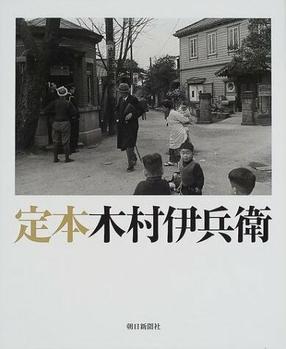
Ihei Kimura was a Japanese photographer, known for his portrayal of Tokyo and Akita Prefecture.

Angelic Pretty is a Japanese apparel brand specializing in lolita fashion. The brand was established as Pretty in 1979 by Hiroko Honda, with its flagship store opened at Laforet in the Harajuku region of Tokyo, Japan, selling apparel from amateur designers. After Honda decided to focus on original apparel, the store was rebranded as Angelic Pretty in 2001.
Shoichi Aoki is a former computer programmer, now Japanese photographer, and creator of the magazines STREET,TUNE, and FRUiTS. He also subsequently created the Fruits and Fresh Fruits photo books as a way of offering his photos to the foreign market.
Shōmei Tōmatsu was a Japanese photographer. He is known primarily for his images that depict the impact of World War II on Japan and the subsequent occupation of U.S. forces. As one of the leading postwar photographers, Tōmatsu is attributed with influencing the younger generations of photographers including those associated with the magazine Provoke.

Shunkichi Kikuchi was a Japanese photographer best known for his documentation of Hiroshima and Tokyo immediately after the war.

Kiriko Takemura, known professionally as Kyary Pamyu Pamyu, is a Japanese tarento, singer, and model. Her public image is associated with Japan's kawaii and decora culture, centered in the Harajuku neighborhood of Tokyo. Kyary's music is produced by musician Yasutaka Nakata of electronic music duo Capsule.
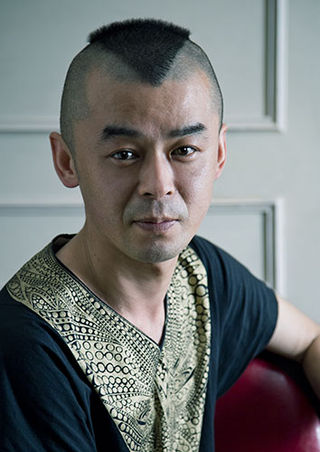
Hideki Seo was a Japanese-born French fashion designer and artist.
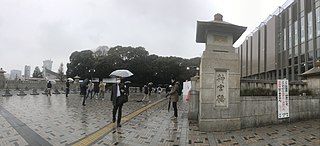
Jingūbashi, lit. Shrine Bridge, also known as Harajuku Bridge or Harajuku Cosplay Bridge, is a bridge that passes over the Yamanote Line between Harajuku Station and the entrance to the Meiji Shrine in Tokyo, Japan. Formerly a pedestrian bridge, it is now open to traffic. With its wide pedestrian area, it is well known as a spot for cosplayers and fashion performers, which in turn led to it becoming a tourist attraction.
"Genderless" is a fashion subculture that emerged in Japan in the mid-2010s. Aiming to break societal gender norms in fashion, the genderless subculture is centered on gender non-conforming androgynous fashion. The subculture is mostly dominated by men, who are known as "genderless men".
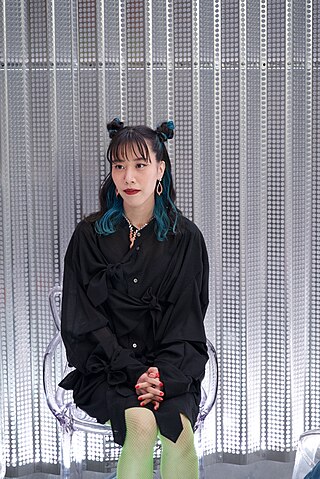
Emi Kusano is a Japanese multidisciplinary artist based in Tokyo. She is recognized for her integration of artificial intelligence into retro-futuristic artwork. In a collaboration with Christie's New York, an auction house, and Gucci, she unveiled an AI-generated 3D dress.
Ayano Sudo is a Japanese contemporary artist and photographer. She won the 2014 Canon New Cosmos Photography Competition and photographs professionally for Japanese magazines such as Spoon and FREECELL. Her works have been shown domestically in Japan and internationally and are included in the collections of museums such as the Tokyo Photographic Art Museum and the George Eastman Museum.













